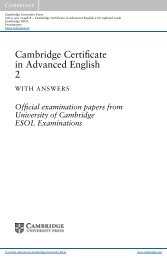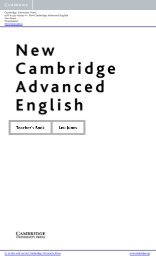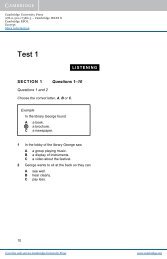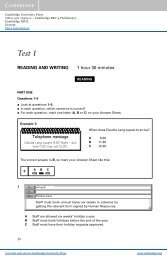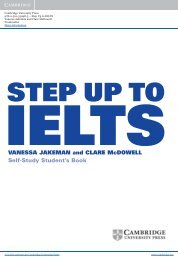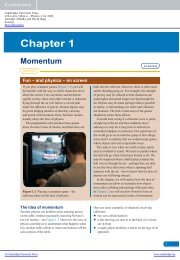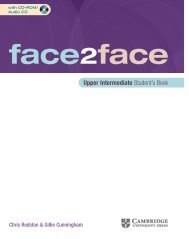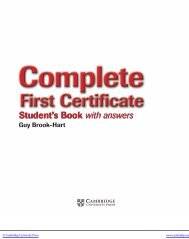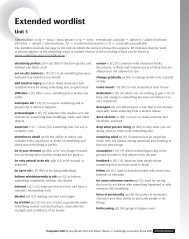2hAnswersDefinition of contrappostoA classical technique used in the visual arts to make a human <strong>for</strong>m appearmore lifelike. In contrapposto, the weight of the subject is taken on one foot tocreate the impression of movement.The historical periods when contrapposto was used in artWas used in the Classical period and also during the Renaissance periodin Italy.The difference between Albrecht Dürer’s work be<strong>for</strong>e and after visiting Italy in 1495:Be<strong>for</strong>eDoes not use Classical effects (yet even so appears more natural than his workafter returning from Italy).AfterUses effects from Classical art, such as contrapposto, in his work.2iAnswersNote: Text B is reproduced below. Differences between this and Text A areunderlined; comments about the implication of the change are given in italics.Text B‘Contrapposto’ is a classical technique used in the visual arts to make the human<strong>for</strong>m appear more lifelike, or dynamic (more definite statement than Text A). Insculpture and drawings of the human body, the weight of the subject is takenon one foot, with the arms and shoulders twisting away to create movement(again, this is more certain). During the Middle Ages this technique was never used,with artists unconcerned about creating true-to-life impressions of human beings(strong statements without caution). This technique was revived in RenaissanceItaly and can be seen in the work of fifteenth- and sixteenth-century artists fromacross Europe.The German artist Albrecht Dürer first visited Italy in 1494, with his sketches fromaround the time of this visit inspired by classical art (implies all of his sketches,from be<strong>for</strong>e and after 1494, inspired by classical art; Text A states only after 1494are there classical influences). It is worthwhile to compare Dürer’s 1493 drawing ofa bathhouse girl with his 1495 drawing of a woman seen from the back (no explicitexplanation as to why, unlike Text A). Dürer’s 1495 drawing is of classical sculpture:it imitates classical models (again, definite about what the artist is doing, unlike TextA which is less certain). His subject is standing according to classical contrapposto:she is ready <strong>for</strong> action, with her weight taken on the right leg (again, more certainty).In spite of this technique, which creates greater realism, the pose is not natural (nocaution). In fact, compared to his 1493 drawing of a bathhouse girl, who is standingupright with no attempt to imitate classical sculpture or use contrapposto, the 1495drawing is unnatural, with an unrealistic posture (stronger claim).It is a matter of debate why the 1493 drawing, which does not attempt contrapposto,manages to create a more convincingly natural, or realistic, impression of a woman’sposture than the 1495 drawing (stronger claim). Dürer felt that he had createdcontrapposto in his 1495 drawing, and there<strong>for</strong>e a more natural look, and wished togive an impression of the classical sculpture he had seen on his travels (how doesthe writer know this? No caution and could be contested easily by the reader).Unit 4 Part B ∙ Understanding written in<strong>for</strong>mation 114
2jAnswersSummary A:Both good points and bad points. The main point of the summary is consistentwith the author’s position in the original text (that Northern European art isas beautiful and realistic as Italian art during the Renaissance, even though itlargely used different techniques), but some in<strong>for</strong>mation misunderstood fromthe original, e.g. Northern artists only drew animals / did not use Maths. It doessummarize the original in other words.Summary B:The best summary of the three. Accurately describes the author’s position andputs the in<strong>for</strong>mation into other words.Summary C:The worst summary of the three. Some in<strong>for</strong>mation not in the original text, e.g.didn’t say Art History changed dramatically; no mention of human images being‘unreal’ and ‘unattractive’, just presumed that’s what the author meant; nomention of classical ‘paintings’ in the original (as classical painting extremelyscarce); Jan van Eyck used different techniques other than ‘Italian’ techniquesto make his art beautiful and realistic. The summary doesn’t refer to theauthor’s position at all.2kAnswersThe writer seems to describe Henstock’s position, but it is not accurate. Thewriter of this text suggests that Dutch artists didn’t use any ‘Italian’ techniquesduring the Renaissance:“Henstock (2010) indicates that Northern European and Italian artists of theRenaissance were using different techniques to attain beauty and reality in theirart, with Italian artists looking to scientific teachings on proportion, and Dutchartists drawing from life and imitating detail in their art.”In fact, Henstock (in 2c) suggests that Dutch artists were not only using Italiantechniques, suggesting that they did use some of them: “… but did not tryto recreate the world only by using the Italian techniques of perspective orproportion”.2l Note: This is based on what is written in ‘Henstock, 2010’ (Text B in 2d).AnswersDefinition A: Henstock is not likely to agree with this definition: there is nothing inthe text to support this definition of beauty.Definition B: It could be argued that Henstock would agree with this definition, asthe text mentions that the Renaissance revived ‘true-to-life art of classical times’,which made it beautiful and realistic. Henstock says that Northern European artwas as beautiful as Italian art, and it copied detailed images from life. If an image isrealistic, an observer may there<strong>for</strong>e think it’s beautiful? The text doesn’t mention thesubjective nature of beauty specifically, however.Definition C: Henstock is most likely to agree with this definition, as classical writingon proportion is mentioned, with Mathematics assisting “artists in the recreation ofnature’s beauty in sculpture, architecture and paintings” in both Italy and NorthernEurope (albeit to a lesser extent).2m Students check their answers to 2j–2l with a partner.Unit 4 Part B ∙ Understanding written in<strong>for</strong>mation 115
- Page 1 and 2:
Skillsfor StudyLEVEL 2Teacher’s N
- Page 3 and 4:
IntroductionThe Skills and Language
- Page 5 and 6:
Introductioncases, even in texts wh
- Page 7 and 8:
Unit 1Gender issuesUnit OverviewPar
- Page 9 and 10:
Women are oftenenrolled on lesspres
- Page 11 and 12:
2b Students take turns presenting t
- Page 13 and 14:
Note: There is a deliberate flaw in
- Page 16 and 17:
Passage cGender gap in higher educa
- Page 18 and 19:
3dAnswersThe correct readings are:F
- Page 20 and 21:
Unit Task: The gender gap1 Students
- Page 22 and 23:
1fAnswersFaiola, A. (2008, May 16).
- Page 24 and 25:
Copy information directlyfrom a lab
- Page 26 and 27:
European Commission. (2009). She Fi
- Page 28 and 29:
2cSuggested answersAccording to Fig
- Page 30 and 31:
Suggested answersGraphic Strengths
- Page 32 and 33:
Suggested answersFeatureStructures
- Page 34 and 35:
Quite separately from the issue of
- Page 36 and 37:
5b Group discussion5c Students inve
- Page 38 and 39:
Unit 2WaterPart AUnderstanding spok
- Page 40 and 41:
1jAnswersYes, I agreeOn top of that
- Page 42 and 43:
Assignment 1aAnswersArid: A very dr
- Page 44 and 45:
Assignment 2Note: The unit task for
- Page 46 and 47:
1c Group discussion1dSuggested answ
- Page 48 and 49:
3dSuggested answers1 To determine w
- Page 50 and 51:
Part CInvestigatingThe aim of this
- Page 52 and 53:
3aSuggested answersList all the pos
- Page 54 and 55:
4bSuggested answers1 introductory s
- Page 56 and 57:
4hSuggested answerProbably not real
- Page 58 and 59:
Part DReporting in speechThe aim of
- Page 60 and 61:
4bSuggested answersYou want to go b
- Page 62 and 63:
Part EReporting in writingThe aim o
- Page 64 and 65: 2cSuggested answersDetermining the
- Page 66 and 67: 3gExample of the rewritten sectionE
- Page 68 and 69: BDiscussionFlow rate increases with
- Page 70 and 71: Suggested answers1Feasibility repor
- Page 72 and 73: water sources is that considerable
- Page 74 and 75: we therefore recommend that the com
- Page 76 and 77: Unit 3ProgressPart AUnderstanding s
- Page 78 and 79: 4b See 4c for answers.4cAnswers3.5S
- Page 80 and 81: Unit Task: Traditional, complementa
- Page 82 and 83: 2dAnswersBeginning / ending of a se
- Page 84 and 85: 4bAnswersDate Test subjects Effects
- Page 86 and 87: Part CInvestigatingThe aim of this
- Page 88 and 89: 2bSuggested answers• Only a littl
- Page 90 and 91: Passage 3aStudies of acupuncture al
- Page 92 and 93: 4eSuggested answers1Presents factua
- Page 94 and 95: One study by the WHO indicates that
- Page 96 and 97: Part DReporting in speechThe aim of
- Page 98 and 99: Unit Task: Traditional, complementa
- Page 100 and 101: 1gSuggested answersSource A (Kirkup
- Page 102 and 103: Source B: Cohen, 2009.Paragraph Mai
- Page 104 and 105: So far I have successfully complete
- Page 106 and 107: Unit 4Art, creativity and designPar
- Page 108 and 109: 4.23aSuggested answers1 The survey
- Page 110 and 111: defStudents listen again to judge t
- Page 112 and 113: Note: In the next series of activit
- Page 116 and 117: 3 Reading critically3aAnswersAbilit
- Page 118 and 119: Dürer’s 1495 drawing is of class
- Page 120 and 121: To summarize, art and architecture
- Page 122 and 123: 2 Analyzing the suitability of samp
- Page 124 and 125: Part DReporting in speechThe aim of
- Page 126 and 127: 2fAnswers1 Speaker 1 gives an expli
- Page 128 and 129: 1c Note: As this activity depends t
- Page 130 and 131: Example research proposal abstract
- Page 132 and 133: 2iExample abstractFeatures of the p
- Page 134: The terms ‘Harvard style’, ‘H



